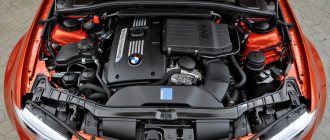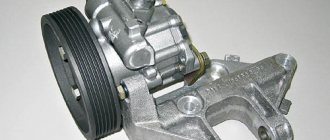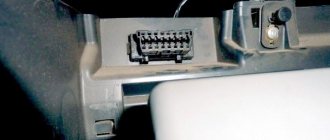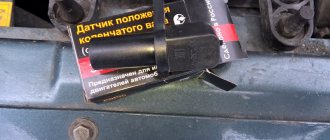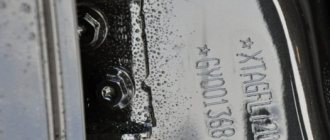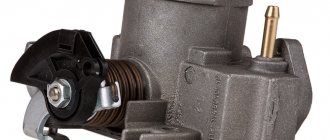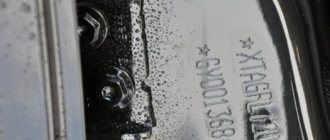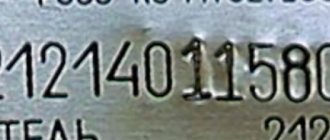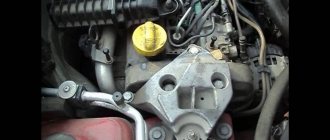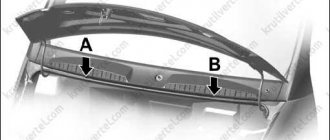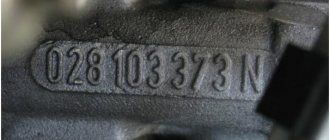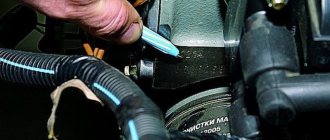Your car Everything you need to know about your car
Menu
November 8, 2022 Did you like the material? Share with your friends!
VIN code (Vehicle Identification Number) is a vehicle identification number consisting of a combination of digital and alphabetic symbols. The code is a mandatory element of marking and is individual for each vehicle (for 30 years).
It all started in 1977, when the ISO 3779 standard was adopted in the USA and Canada, which described the format of VIN numbers.
Currently, the international standard ISO 3779:1983 is in force (latest edition - from 1996), the world manufacturer index (WMI - part of the code) is determined by the ISO 3780:1983 standard.
The identification number is located on a non-removable part of the body in places least susceptible to destruction in an accident and is duplicated on a plate located in the front of the car. The VIN of modern cars is located on the front left pillar of the body and the upper left part of the dashboard.
If a vehicle is manufactured sequentially by several enterprises, it is permissible to apply the main marking of the vehicle only by the manufacturer of the final product.
The VIN number consists of 17 characters - Latin letters and numbers. At the same time, the symbols I, O and Q are not used in code combinations due to their similarity with the numbers 1 and 0.
Each character of the VIN number carries information about one or another characteristic of the car: the country and manufacturer, date of manufacture, technical characteristics, etc.
The vehicle VIN number consists of three parts: WMI VDS VIS
- WMI (World Manufacturers Identification) - world manufacturer index (1st to 3rd characters of the number);
- VD S (Vehicle Description Section) - descriptive part (from the 4th to the 9th characters of the number);
- VIS (Vehicle Identification Section) - distinctive part (from the 10th to the 17th characters of the VIN number)
Preface
1 DEVELOPED by the All-Russian Research Institute of Standardization and Certification in Mechanical Engineering (VNIINMASH)
INTRODUCED by the Technical Committee for Standardization TC 56 “Road Transport”
2 ADOPTED AND ENTERED INTO EFFECT by Resolution of the State Standard of Russia dated December 15, 2002 No. 469-st
3 Sections (subsections, appendices) of this standard, with the exception of section 1, paragraphs 2.1 and 3.2.8, subsection 3.3 and Appendix B, are identical to the text of international standards ISO 3779-83 “Road transport. Vehicle identification number. Content and structure", ISO 3780-83 "Road transport. International Manufacturers Identification Code”, ISO 4030-83 “Road vehicles. Vehicle identification number. Location and installation"
4 INTRODUCED FOR THE FIRST TIME
GOST R 51980-2002
STATE STANDARD OF THE RUSSIAN FEDERATION
Vehicles
General technical requirements
Vehicles. Marking. General technical requirements
Date of introduction 2004-01-01
This standard establishes general technical requirements for the content of the identification number (code) and the vehicle manufacturer's plate (hereinafter referred to as the vehicle), as well as for their location on the vehicle and the method of applying code signs.
In this standard, the following terms with corresponding definitions apply:
2.1 vehicles (vehicles):
Motor vehicles and wheeled self-propelled equipment of other types.
2.2 vehicle identification number (code)
— Vehicle Identification Number, VIN (hereinafter referred to as the VIN code): A structural combination of characters assigned to a vehicle for the purpose of its identification.
2.3 international manufacturer identification code
— World Manufacturer Identifier, WMI (hereinafter referred to as the WMI code): The first section of the VIN code, indicating the vehicle manufacturer. The WMI code is assigned to the vehicle manufacturer for the purpose of identifying this manufacturer. The WMI code, when used in conjunction with other sections of the VIN code, ensures the uniqueness of the latter for all vehicles produced within 30 years in all countries of the world.
2.4 descriptive part of the VIN code
— Vehicle Descriptor Section, VDS: The second section of the VIN code. Contains information describing the main features of the vehicle. This section of the VIN code can indicate the vehicle type, type variants and versions.
2.5 index part of the VIN code
— Vehicle Indicator Section, VIS: The third section of the VIN code. Consists of a combination of signs assigned by the manufacturer in order to distinguish one vehicle from another. This section of the VIN code, together with the VDS, provides unique identification of all vehicles produced by each manufacturer over a 30-year period.
2.6 manufacturer:
The person or organization responsible for the vehicle, assembled until it is ready for use. The manufacturer is also responsible for the uniqueness of the VIN code.
2.7 delimiter:
A symbol, sign, or other boundary designation that can be used to delimit sections of a VIN code or indicate the beginning and end of a VIN code. Separators must be such that they cannot be mistaken for Arabic numerals or Latin letters.
2.8 year of issue:
Calendar year in which the vehicle was produced.
2.9 model year:
The conditional year indicated by the manufacturer (usually following the actual year of manufacture of the vehicle).
Identification numbers of Lada Granta.
Identification numbers of Lada Granta.
Location of identification numbers in the engine compartment. 1 — vehicle identification number;
2 — engine number (on the top of the cylinder block, above the clutch housing);
3 — a summary plate with the vehicle’s passport data.
According to existing legislation, each vehicle has an identification number (VlN code). This number is recorded in the vehicle passport (PTS). The identification number and other passport data of the vehicle are indicated in the summary plate.
The identification number is stamped in the engine compartment on the amplifier (support cup) of the right mudguard.
An identification number.
Summary plate.
1 — number for spare parts (corresponds to the serial number of the car that came off the assembly line);
WMI
WMI - International Manufacturer Identification Code. Consists of three characters (letters or numbers).
The first character indicates a geographic area, the second indicates a country within that area, and the third indicates a specific manufacturer (sometimes a vehicle type).
If the manufacturer produces less than 500 DTS per year, then the third character of the code is the number 9.
Several WMIs may be assigned to a manufacturer, but the same number may not be assigned to another vehicle manufacturer for at least 30 years from the moment it was first used by the previous (first) manufacturer.
So, the first character of WMI is a letter or number representing the geographic area code. Each zone is assigned several symbols:
- from A to H - Africa;
- from J to R - Asia;
- from S to Z - Europe;
- from 1 to 5 - North America;
- from 6 to 7 - Oceania;
- from 8 to 9 - South America;
The second character (country code) is a letter or number that represents the country. To ensure flexibility and unambiguity in identification, a specific country is determined by a combination of the first and second digits of the code:
Despite the parameters clearly stated in the standard, the designation assigned to the country of origin is not always used. For example, cars of the European branch of General Motors, whose head office is in Germany, are labeled as W0, regardless of the country of origin (be it Germany, Spain, Great Britain, Belgium or Poland).
The third character is a letter or number that is assigned to the manufacturer by the national organization. Can also mean vehicle type or production department.
Vehicle registration details
The rating data is given on the plate attached to the upper cross member of the radiator frame on the right side. The Vehicle Identification Number (VIN) is stamped on the right mudguard cup, near the shock absorber upper mount mount.
Vehicle registration details in the engine compartment
: 1 – vehicle identification number (VIN); 2 – vehicle data plate. The identification number is deciphered as follows: XTA
– according to international standards, denotes the manufacturer’s code;
219000
– car model;
C
(letter of the Latin alphabet or number) – model year of the car;
0000000
– body number.
: "AVTOVAZ"
– designation of the manufacturer.
No. E – RU.MT02.В.00232
– vehicle type approval number;
XTA219000 C 0000000
– vehicle VIN;
1560
– permissible gross vehicle weight, kg;
2460
– permissible weight of a vehicle with a trailer equipped with brakes, kg;
1–810
– maximum permissible load on the front axle, kg;
2–850
maximum permissible load on the rear axle, kg;
vertical inscription on the left No. for spare parts
– indicates the number for spare parts; The vertical inscription on the right indicates the engine model.
VDS
The second part of the VIN code is the description - a descriptor of the car.
The 4th, 5th, 6th, 7th, 8th characters are used to determine the type of vehicle and describe the characteristics of the vehicle:
- model line,
- body type,
- engine's type,
- steering wheel position,
- power system and transmission type,
- drive unit,
- etc.
Each manufacturer has its own set of parameters, its own sequence and its own unique designations.
The 8th character is used in most cases to determine the engine type. Unused positions are filled with signs at the discretion of the manufacturer.
The 9th character - for manufacturers in the USA and China (as well as those who export cars to the USA) - is a check digit, which is one of the means of protection against number alterations. European, Japanese and Korean companies do not always follow the standard, and use this symbol for additional information about the car.
Decoding VIN VAZ (Lada) Granta
Autobius is a universal VIN decoder that allows you to decipher the VIN of VAZ (Lada) Granta cars. Each VAZ (Lada) Granta car has a unique identification code called VIN. This number contains important information about the car, such as its manufacturer, year of manufacture, plant where it was made, engine type, model and much more. For example, if someone wants to buy a car, they can check VIN number one in an online database to ensure that the car has not been stolen, damaged or illegally altered. The VIN number has a specific format that is recognized throughout the world. This format was introduced by the ISO Institute. Every car manufacturer is required to label all their vehicles in this special format. This online service allows the user to check the validity of the car and get detailed information on almost any VIN number, find car parts and check the car's history. VIN decoding also allows the user to check the market value of a new or used VAZ (Lada) Granta car.
VIS
The third part of the VIN - the index part of the identification number (VIS) - consists of eight characters, and the last four characters of this section must be numbers. Moreover, information about the model year and manufacturer is not strictly fixed by the standard, but is only advisory in nature.
The 10th character of the VIN usually indicates the model year of the vehicle.
It must be remembered that the model year can be significantly ahead of the calendar year and counted not from January 1, but, for example, from August (Audi) or July (VAZ) of the previous calendar year
Some manufacturers, such as Renault, Mercedes-Benz, Toyota, do not indicate the model year in the VIN code at all. The year of manufacture is indicated on a plate on the body.
However, cars produced for the American market are all labeled strictly according to the standard.
In addition to the three letters prohibited for use in the VIN (I, O and Q), the letters U, Z and the number 0 are also not used to encode the model year.
The European branch of Ford in the VIN code indicates the production date as fully as possible: in the 11th position there is a symbol for the year of production, and in the 12th position there is a month.
Ford production date table:
The 11th character most often indicates the vehicle’s assembly plant (each manufacturer has its own designation system - its own letters).
The 12th, 13th, 14th, 15th, 16th, 17th characters are assigned to the serial number of the car. They indicate the production sequence of the vehicle.
Identification numbers of Lada Granta.
Identification numbers of Lada Granta.
Location of identification numbers in the engine compartment. 1 — vehicle identification number;
2 — engine number (on the top of the cylinder block, above the clutch housing);
3 — a summary plate with the vehicle’s passport data.
According to existing legislation, each vehicle has an identification number (VlN code). This number is recorded in the vehicle passport (PTS). The identification number and other passport data of the vehicle are indicated in the summary plate.
The identification number is stamped in the engine compartment on the amplifier (support cup) of the right mudguard.
What is VIN number
VIN (vehicle identification number) is a series of alphabetic and numeric characters applied to a specific part of the body by the vehicle manufacturer. It represents encoded information about the vehicle.
A single VIN number was adopted in 1980 to unify vehicle identification at the global level. The VIN number consists of seventeen positions (English letters and numbers) in which information is encoded: brand, model range, year of assembly and numerous technical parameters.
Vehicle VIN code structure
The vehicle identification code is divided into three parts:
- WMI (transport manufacturer code);
- VDI (vehicle performance description);
- VIS (vehicle identifier).
WMI is a vehicle identifier, consisting of the first three positions of the vehicle identification code. They encode data about the country of origin (the first two characters) and the company that manufactured the vehicle.
WMI determines the region where the vehicle was assembled, not the origin of the brand. Large automobile concerns have a number of different identifiers assigned to them.
VDS is a sequence of six characters, positions four through nine. It encodes information about the vehicle model, configuration options and basic technical parameters.
The fourth character can be coded for the body type, the fifth position for the engine type, and the sixth position for the model.
Different manufacturers encode various characteristics in VDI in their own way, but the model can always be determined. The ninth position is a check position to control the accuracy of the VIN code.
VIS is a vehicle identifier consisting of eight characters. The tenth position indicates the year of manufacture of the car, the eleventh position indicates the plant that assembled the car.
The last six characters contain the vehicle serial number.
Many of the well-known automakers: Audi, Volkswagen, Opel, Peugeot, Renault, Rover, Volvo, Jaguar, Isuzu, Kia, Toyota, Nissan write the last four positions in numbers, and some European and Japanese automakers may not indicate the year of manufacture at all.
The procedure for deciphering the VIN code by numbers
The VIN code never contains the Latin alphabetic characters “I”, “O” and “Q” due to some similarity with the numbers “1” and “0”.
Decoding the VIN code yourself is a rather labor-intensive process.
The VIN number shown in the picture below will be used as an example of decoding.
The positions of the VIN code must be deciphered strictly in order.
1 - country
The first position in the VIN code always indicates the country of manufacture of the car. In other cases, several characters are used to identify the country.
There are a lot of codes designating regions, but the most common are:
- 1, 4 and 5 - United States of America;
- 2 - Canada;
- 3 - Mexico;
- J - Japan;
- K – Korea;
- S – Great Britain;
- W – Germany;
- Z – Italy;
- Y – Sweden;
- X – Russia, the Netherlands and Uzbekistan;
- 9 – Brazil.
In the picture, the first character is X, the country of origin is Russia, the Netherlands or Uzbekistan.
2 and 3 - vehicle manufacturer
The next two positions show the vehicle manufacturer.
The codes of many international companies consist of several characters. Like country identification, plant identification may require all three characters.
The picture shows two 7L symbols; you have to search using all three symbols X7L—Renault AvtoFramos (Russia).
The Renault concern has many factories: MEE - India, VF1, VF2, VF6 (trucks) and others. For example, AVTOVAZ has the code XTA.
To designate a manufacturer producing less than five hundred vehicles per year, the number nine is indicated in the third position.
From 4 to 8 digits - characteristics
The fourth to eighth characters describe the various characteristics of the vehicle and its type:
- the lineup;
- body type;
- drive unit;
- engine;
- transmission;
- steering wheel locations and others.
Each car manufacturer has its own set of characteristics, its own unique designations.
We will consider according to the classification for Renault assembled in Russia.
- C or 3 - three-door hatchback;
- B or 5 - five-door hatchback;
- S or 6 - five-door combi;
- K or A - three-door station wagon;
- E or 7 - two-door convertible/truck with sides;
- D or 8 – two-door coupe/convertible;
- J or N - five-door station wagon/minivan;
- U or H - pickup;
- M or 2 - two-door sedan;
- L or 4 - four-door sedan.
In our case, the first letter L denotes the vehicle body type—sedan.
A number of models presented in Russia are encrypted in the fifth position:
- A - Megan I;
- B – Clio II;
- C – Kangoo;
- D – Master;
- G – Laguna II;
- L – Traffic;
- M – Megan II;
- S – Logan;
- Y – Koleos.
The fifth position in our case indicates the S – Logan model range.
The sixth and seventh positions for this example indicate the engine code - RB, in the example under consideration the KJ7 engine - engine capacity 1.4 liters, eight-valve.
In the eighth position is the territorial location of the plant that produced the vehicle.
Cars that came off the Avtoframos assembly line have the same code as Turkish vehicles - 2.
9th number - check digit
Most automobile concerns use a symbol in the ninth position to check the check digit, which is calculated: all numbers and Latin letters (each letter is assigned its own digital value) in each position of the VIN code are multiplied by the position number code (multiplier), with the exception of the check digit, and the sum of the products all positions are divided by eleven.
If the remainder in the received response is similar to the control value, the VIN code is real.
Digital values of VIN letters: A=1, B=2, C=3, D=4, E=5, F=6, G=7, H=8, J=1, K=2, L=3, M =4, N=5, O=6, P=7, R=9, S=2, T=3, U=4, V=5, W=6, X=7, Y=8, Z=9 .
Position code (multiplier): 1st=8, 2nd=7, 3rd=6, 4th=5, 5th=4, 6th=3, 7th=2, 8- 1st=10, 9th=0 (check digit), 10th=9, 11th=8, 12th=7, 13th=6, 14th=5, 15th=4, 16th=3, 17th=2.
10 letter (number) - year of manufacture of the car
The symbol in the tenth position indicates the year of manufacture of the vehicle.
Not every vehicle manufacturer follows this regulation.
| 1971 | 1 | 1986 | G | 2001 | 1 |
| 1972 | 2 | 1987 | H | 2002 | 2 |
| 1973 | 3 | 1988 | J | 2003 | 3 |
| 1974 | 4 | 1989 | K | 2004 | 4 |
| 1975 | 5 | 1990 | L | 2005 | 5 |
| 1976 | 6 | 1991 | M | 2006 | 6 |
| 1977 | 7 | 1992 | N | 2007 | 7 |
| 1978 | 8 | 1993 | P | 2008 | 8 |
| 1979 | 9 | 1994 | R | 2009 | 9 |
| 1980 | A | 1995 | S | 2010 | A |
| 1981 | B | 1996 | T | 2011 | B |
| 1982 | C | 1997 | V | 2012 | C |
| 1983 | D | 1998 | W | 2013 | D |
| 1984 | E | 1999 | X | 2014 | E |
| 1985 | F | 2000 | Y |
How to determine the modification of a car body
Sometimes, in order to decide on the right products for a car, modification of the body is necessary. To determine the modification, you need STS, VIN or FRAME of the car.
STS, or vehicle registration certificate, is a card that every car owner has:
VIN is a code that encrypts information about the car. All cars officially sold in Russia have it. But if the car was brought privately from Japan, it will not have a VIN code.
Instead of VIN they have FRAME, or body number. To determine the modification of the body, it is usually sufficient.
Sometimes the body modification is contained directly in the VIN or FRAME.
If you cannot determine the body using the STS, use the websites ilcats.ru and elcats.ru. These are free services for searching information by VIN.
Let's look at VIN JTDBZ42E999032663 as an example. Go to ilcats.ru, enter the VIN in the upper left corner.
We see a modification - ZZE141L-AEPDKV.
It’s the same on elcats.ru, but here you need to first select the car brand. The # sign in automobile catalogs means that any numbers can be substituted in this place.
Now, knowing the modification of the body, you can safely go to plastik-avto.ru - you definitely can’t go wrong with the choice of product
